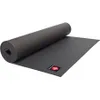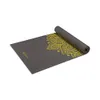
Anyone looking to build mobility and improve muscular balance, control, coordination and core strength should be adding candlestick rolls to a mobility routine.
Found commonly in gymnastics, candlestick rolls look a bit like a reverse burpee, combining the momentum of a spinal roll with a squat to stand, building core and lower body strength, mobility and stability.
I love and hate this exercise in equal measure; because it’s brilliant for warming up before barbell squats and it humbles me every time. Here’s how to do the candlestick roll, the benefits and ways to scale. Grab one of the best yoga mats for mobility exercises, and read on.
What is a candlestick roll?
As is always the case in the fitness industry, you’ll see multiple names for the same (or similar) exercises. Candlestick rolls look like reverse burpees or stand-up sit-ups, although they’re approached slightly differently.
Reverse burpees are faster and feature a jump at the end, typically following a burpee progression. In contrast, the stand-up sit-up is a slower, core-focused move using an anchor for your feet and without jumping or raising your legs overhead on the ground.
How to do candlestick rolls
To execute the candlestick roll, you’ll start standing, lower toward the ground, then roll back, drive your arms overhead and legs into the air and use the momentum of the roll to initiate standing back up.
- Start standing with feet hip-width or closer
- Squat and send your hips backward, lowering your glutes toward your heels
- Roll onto your back, extend your arms overhead and roll from hips onto shoulders, pressing the backs of your hands down behind you for support
- Extend both legs into the air overhead, driving your toes toward the ceiling and creating a straight line from hip to toe
- Squeeze your glutes, quads and stomach muscles and lengthen through your spine
- Roll forward, drive your heels toward your glutes and sit up, then press your heels into the ground close to your glutes
- Keeping your shoulders over your feet and leaning slightly forward, press through your legs and core to stand
Benefits of the candlestick roll
Candlestick rolls are great for warming up before barbell squats, recruiting the hips, core, glutes and legs, while developing mobility, control and power. The rocking motion helps mobilize and gently massage the spine, and piecing the various stages of the exercise together could improve balance, coordination and lower body strength while activating the back body.
Sign up to get the BEST of Tom's Guide direct to your inbox.
Get instant access to breaking news, the hottest reviews, great deals and helpful tips.
If your goal is to work on squat depth (think the first portion of the candlestick roll) and explosive power as you push through your legs to stand (the last part of the exercise and the concentric phase of a squat), then candlestick rolls are the perfect mobility drill for squats.
The exercise targets the back, quads, hamstrings, glutes, hip flexors and various stabilizing core muscles like the rectus abdominis, transverse abdominis, obliques and erector spinae.
Even if you don’t nail the exercise every time, practicing the eccentric (lowering down) phase will help you develop control and hip, knee and ankle mobility, and the roll combined with the push-to-stand will improve core and leg strength and power. And the best part is, you’re still developing the all-important mind-muscle connection.
Famously, a narrow foot stance takes greater mobility for most people and turns a squat quad dominant — it can take some time to feel comfortable sitting low enough to roll back, so focus on the exercise as a development of skill rather than a finished product.
Candlestick rolls: Common mistakes
Avoid a wide foot position and keep your feet hip-width or closer, maintaining a tripod position with your feet — press through your little and big toes and heels rather than lifting your heels or balancing on the balls of your feet.
Another common mistake is hunching; avoid rounding the spine and stand tall instead, using the mobility in your joints rather than hunching over to find enough space to squat. You’ll only need to slightly round your back as you rock and roll.
If the move doesn’t feel accessible, practice placing your hands on the ground close to your hips for extra support as you press your legs overhead and stand. Place a firm crash pad (or similar) beneath you for elevation if you still struggle to stand, as this will help you place your feet down. Gradually reduce the elevation as you find it easier to stand.
Here's why I love candlestick rolls
I discovered the candlestick roll during a CrossFit class, and it’s often used to help progress gymnastics exercises on the bar, like muscle-ups. I love that it teaches your mind and muscles to work together, improving mobility and understanding of where your body is in space — something called proprioception.
Candlesticks are a compound exercise, meaning multiple muscles are active. Like many gymnastics or calisthenics-based exercises, it’s part of functional training because it mimics standing up from a lying position.
The move does it all. It combines core strength and stability development with mobility and power, firing up the central nervous system and working your joints through a full range of motion.
If you feel ready to progress the exercise, try holding a plate overhead in both hands to prepare for exercises like overhead squats, jerks, or snatches that require thoracic and shoulder mobility, or working on single-leg variations to help tighten up your pistol squats.
More from Tom's Guide
- Forget the gym — 7 bodyweight exercises that strengthen and define your entire body
- Ditch the sit-ups — this 4-move bodyweight workout builds your core and improves posture at the same time
- This 5-move bodyweight routine activates your glutes and builds hip flexibility for lower body workouts

Sam Hopes is a level 3 qualified trainer, level 2 reiki practitioner and senior fitness writer at Tom's Guide. She is also currently undertaking her Yoga For Athletes training course. Sam has written for various fitness brands and websites over the years and has experience across brands at Future such as Live Science, Fit&Well, Coach, and T3.
Having worked with fitness studios like F45 and Virgin Active, Sam now primarily teaches outdoor bootcamps, bodyweight, calisthenics and kettlebells. She also coaches mobility and stretching-focused classes several times a week and believes that true strength comes from a holistic approach to training your body.
Sam has completed two mixed doubles Hyrox competitions in London and the Netherlands and finished her first doubles attempt in 1:11.










